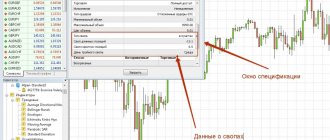Let's start with the fact that in economics the term “liquidity” is very important. And knowing him is highly recommended. Especially if your activity is related to business or private investment.
The term liquidity refers to the ability of an asset to quickly turn into cash without losing value.
Simply put, liquidity is a property that will determine how long it will take to sell a product while it still retains its market price.
If the period is short, then the liquidity is high. And vice versa.
For example, let's take dollars, or any other common currency. Their liquidity is very high, since you can go and exchange at any time without losing much in value.
Here are some more examples.
If you want to sell shares of a large oil company, they will buy them from you immediately, and the difference in cost will be negligible. But if these are shares of a little-known company, then you will have to look for a buyer, and in the end sell them much cheaper than you bought them. The liquidity of this product is low.
Or an example with real estate.
If you have a large house outside the city, then it will also have low liquidity, because it itself is expensive, is not located in a place of easy access, and there are not so many buyers for such real estate on the market.
Another thing is if you are selling an apartment in the city. The demand for secondary housing is very high, the location is convenient, so they will buy it from you quickly. This is a product with high liquidity.
Now let’s see what types of liquidity exist, and then we’ll look at some of them in more detail.
What is liquidity
Liquidity is the ability to turn all existing assets into money. The faster you can sell property with the least loss in market price, the greater the liquidity. For example, currency can be quickly converted into rubles, but for buildings you can look for a buyer for six months and it is not a fact that he will buy it at the original cost.
If problems arise, a liquid company can pay off its debts faster by selling some property and stay afloat. A company is considered liquid if it has more assets (money, property) than liabilities (debts).
Money
The liquidity of money is maximum. Money is also an asset. They can always be exchanged for any material equivalent. Except for cases when they lose their meaning: during times of occupation, coups, hyperinflation, confiscation reforms and other force majeure circumstances. Then liquidity is retained by the currencies of other states or the money of the new state.
For example, USSR rubles lost their liquidity, and new Russian money appeared in their place. During the hyperinflation of the early 1990s, the liquidity of new money weakened. People tried to use them as quickly as possible to buy any product that was becoming more expensive every week. After the abolition of the Soviet article of the Criminal Code on criminal liability for foreign exchange transactions, the US dollar became a reliable currency with high liquidity.
Changes in the liquidity of money are also directly related to inflation: prices for goods rise simultaneously with the fall in the purchasing power of the national currency.
Why evaluate liquidity?
A liquidity assessment is needed if you have intentions to cooperate with a specific enterprise. Thanks to simple calculations, you can understand how many assets a company has, how solvent it is, and whether it can quickly pay off its creditors if necessary.
A company that has money in its account and a stock of products in its warehouse is considered liquid. If necessary, it quickly sells products and pays off debts. Such a company will arrange delivery of goods without prepayment or quickly issue a loan.
A company with low liquidity has debts and empty accounts, so hardly anyone will want to cooperate with it, since they will have to wait a long time for money from it.
How liquid works
An example will help you understand what liquidity is. When a builder (or dental technician) takes cement powder, adds a certain amount of water and forms something (for example, a filling), a solid material is created by combining the powder and liquid.
Liquid (translated from English as “liquid”) and acrylic powder are combined in the same way. A polymerization reaction occurs, as a result of which part of the monomer is released, the dispersion layer. It is also called the “sticky layer”. Remove the dispersion with alcohol.
Types of liquidity and ratios
Liquidity of the enterprise
The liquidity of an enterprise is calculated from the ratio of debt obligations to liquid assets. In other words, the solvency of the company is assessed. This information is publicly available; all company assets can be seen on the balance sheet.
The assets of an enterprise can be current or non-current:
- Current assets are property that brings dividends to the company for no more than one year. These include: deposits for up to 1 year, raw materials, money for settlements with partners, short-term receivables.
- Non-current assets are property and money that generate profit for more than 1 year: long-term deposits, equipment, buildings, patents and projects.
Current assets, unlike non-current assets, are considered more liquid.
Bank liquidity
In fact, this concept is conditional. The term "bank liquidity" usually refers to the ability of a bank to pay out money to all customers who have invested in that bank. The bank has current and non-current assets.
The more current assets (cash, shares, bonds) that can be quickly converted into money, the greater the bank's liquidity. A large number of issued loans reduces the bank's liquidity. The level of solvency of banks in the Russian Federation is under the control of the Central Bank of Russia.
Market liquidity
You can calculate liquidity not only for an individual enterprise, but also for an entire market, for example, for the non-ferrous metals market or for the government services market. If transactions are constantly concluded in the market with a small difference between buying and selling, such a market will have high liquidity. It is important that there are so many transactions that each of them separately could not affect the cost of the goods.
The “black” parameter is taken as a unit of market liquidity, which, with high liquidity, should be greater than 15. This indicator is calculated using the formula:
Chern = the sum of all concluded contracts/the cost of goods actually received under these contracts.
Liquidity of securities
This concept in relation to securities means the ability to be quickly sold at a price close to the market price. Liquidity also characterizes high supply and demand for a security.
Using the example of shares, they distinguish:
- highly liquid,
- low liquidity,
- illiquid.
There are two indicators that affect the liquidity of a security. This is the difference between the highest buy order price and the smallest sell order price (spread) and trading volume (number of completed trades).
The graph below shows that the higher the income from securities, the higher the risks.
Liquidity of money
Money must be equal to its face value. If you can easily pay with them, then they are liquid. Money in countries with good economies has high liquidity. If the purchasing power of money falls and its liquidity decreases, this means that prices for services and goods rise.
Real estate liquidity
If a property can be easily sold, then it is liquid. As a rule, it is not possible to quickly sell an apartment, house or building, since it is necessary to find a buyer and evaluate the asset. A transaction can take a long time to complete, so real estate is less liquid compared to other assets, for example, securities.
Various factors can affect the liquidity of real estate. For example, developed infrastructure will lead to higher prices for houses in the area, and the placement of a landfill will lead to lower prices.
But real estate cannot be called a low-liquid asset. Let's consider the option for an individual. If you have monetary assets, for example, in the amount of 1.5 million rubles, then you can invest them in real estate or open a bank account. If the bank closes, the person will receive compensation of 1.4 million rubles, the rest of the finances will be burned. If he bought an apartment, then it can be sold for this amount or more, depending on various factors.
Liquidity and areas of application
Types of liquidity and their ratios
Before investing money in a company, you need to assess its liquidity. We consider the ratio of debts of this enterprise and working capital. Based on these calculations, it will be clear whether the company will be able to pay its debts to the creditor on time if something goes wrong in the business.
Let's consider and calculate the coefficient for quick, current and absolute real estate.
Quick ratio
Quick liquidity is the ratio of highly liquid assets to short-term liabilities. It is calculated by the formula, where Kdz is accounts receivable, Ds is funds in the account, Kfv is short-term investments, KO is short-term liabilities:
Kbl = (Kdz + Kfv + Ds) / KO
This ratio must be at least 1. In this case, the company is able to pay off its debts, even if it encounters difficulties.
Current ratio
The current liquidity of Ktl (otherwise the coverage ratio) is calculated using the following formula, where OA is current assets, and KO is short-term liabilities:
Ktl = OA/KO
This indicator is responsible for the solvency of the enterprise. The higher the ratio, the more solvent the company. Ideal indicator > 2.
Absolute liquidity ratio
The indicator is calculated similarly to the quick liquidity ratio, but accounts receivable are not taken into account;
Cal = (Ds + Kfv) / KO
A normal value would be 0.2 or higher.
Liquid composition
There are two methods used to model nails – acrylic and gel. Gel is the same acrylic, but polymerizes under the influence of ultraviolet radiation. Photoinitiators are added to it so that the reaction does not occur before the material is placed in the lamp.
What is liquid, what is its chemical composition? This is important because it can be safe or so harmful that it is even banned from use by the Council of Europe. It's all about methacrylic acid, or rather, its ester. The first monomers were created based on MMA, a very harmful compound that causes many diseases. In 2002, this ingredient was abandoned, replaced by EMA.
Liquidity analysis
You can find out the solvency of a company by looking at its balance sheet. Balance sheet liquidity is an indicator of the liquidity of the enterprise. It can be used to determine how the company is doing and whether it can pay off its debts on time.
The main sign of liquidity is the excess of the value of current assets in relation to short-term liabilities. The higher this indicator, the better the company's financial condition and the higher its liquidity.
Specifically, this means whether the company has sufficient funds to pay off short-term obligations.
The company's assets are:
- The most liquid assets (A1) are funds that can quickly cover debts.
- Quickly realizable assets (A2) – this includes current assets that can be converted into money after a certain time.
- Slowly selling assets (A3) are accounts receivable and other inventories, finances for which are expected in a year or later.
- Hard-to-sell assets (A4) are machines and production facilities that cannot be sold quickly.
Current assets are characterized by higher liquidity than company property.
The company's liabilities can also be divided into groups:
- Current liabilities (P1) are payments for loans and credit, payment of dividends, etc.
- Short-term liabilities (P2) are accounts payable that must be repaid within a year.
- Long-term liabilities (P3) – long-term accounts payable.
- Fixed liabilities (P4) – other liabilities.
A comparison of a company's liabilities and assets is used to determine the liquidity of the balance sheet.
What factors influence the liquidity ratio
The liquidity of a company is determined by the number of liquid assets (money in accounts, short-term investments, authorized capital, inventory of goods that can be quickly sold and received money).
The liquidity of a company is influenced by internal factors that can be determined from the charter of the enterprise or from an analysis of financial statements. This is the image and management system of the enterprise, as well as the possibility of rational organization of the structure. The opinions of partners, clients and even competitors, as well as publications about the company in the media are also taken into account.
Theme templates
You can access your theme files from the Themes of your Shopify dashboard:
Desktop
iPhone
Android
- From your Shopify account, go to Online Store > Themes.
- Find the theme you want to edit, then click Actions > Edit code.
- Click on the name of the Liquid file you want to change and edit it.
- Click Save.
- Check the corresponding page of your online store to monitor the result.
- In the Shopify app, click Store.
- Click the... button next to Online Store and then click Manage sales channel.
- Click Themes.
- Find the theme you want to edit, then click Actions > Edit code.
- Click on the name of the Liquid file you want to change and edit it.
- Click Save.
- Check the corresponding page of your online store to monitor the result.
- In the Shopify app, click Store.
- Click the... button next to Online Store and then click Manage sales channel.
- Click Themes.
- Find the theme you want to edit, then click Actions > Edit code.
- Click on the name of the Liquid file you want to change and edit it.
- Click Save.
- Check the corresponding page of your online store to monitor the result.
FAQ
Why is liquidity needed?
The liquidity of a company needs to be determined if you are going to work with it or buy its shares. A liquid company's shares will grow, which means you can increase your money with it. It is also better to cooperate with a liquid company, since in this case it is guaranteed to be able to fulfill its obligations on accounts.
How to assess a company's liquidity? Where can I get the data?
To assess liquidity, you will need the company's financial statements. The balance sheet of an enterprise is open information and can be found on the Internet. You need to compare the company's assets and liabilities to determine how quickly it can pay its bills. Important: there must be more current assets than liabilities. Then you can safely cooperate with the company.
Is a car an asset or a liability?
It all depends on how this car was purchased. If a new car was purchased with the company’s own money, it is a liquid asset. Cars leased or using credit funds, rented, as well as the use of an employee’s personal car for business purposes require additional calculations taking into account costs.










